So far this month of January, we have been meeting, making, and literally, chilling out. Cold weather is the best inspiration for making woolen sweaters, socks, and shawls; they keep your lap warm. January has also been a good month for quilting and sewing small creatures.
At the start of our first session this new year, Martha and I were treated to a gallery of tiny attendees lined up on Kathleen's sofa. 7 of them! Kathleen may have admitted that the beautiful quilt over the back of the sofa is the only one she ever made. And, did I mention? She is a professional sewist and retired from a business that she developed to manufacture clothing and other items to order. A consequence of her retirement is that she has a huge inventory of various leftovers from all the orders over the years and that now provide a constant supply of small animal parts to sew up : )
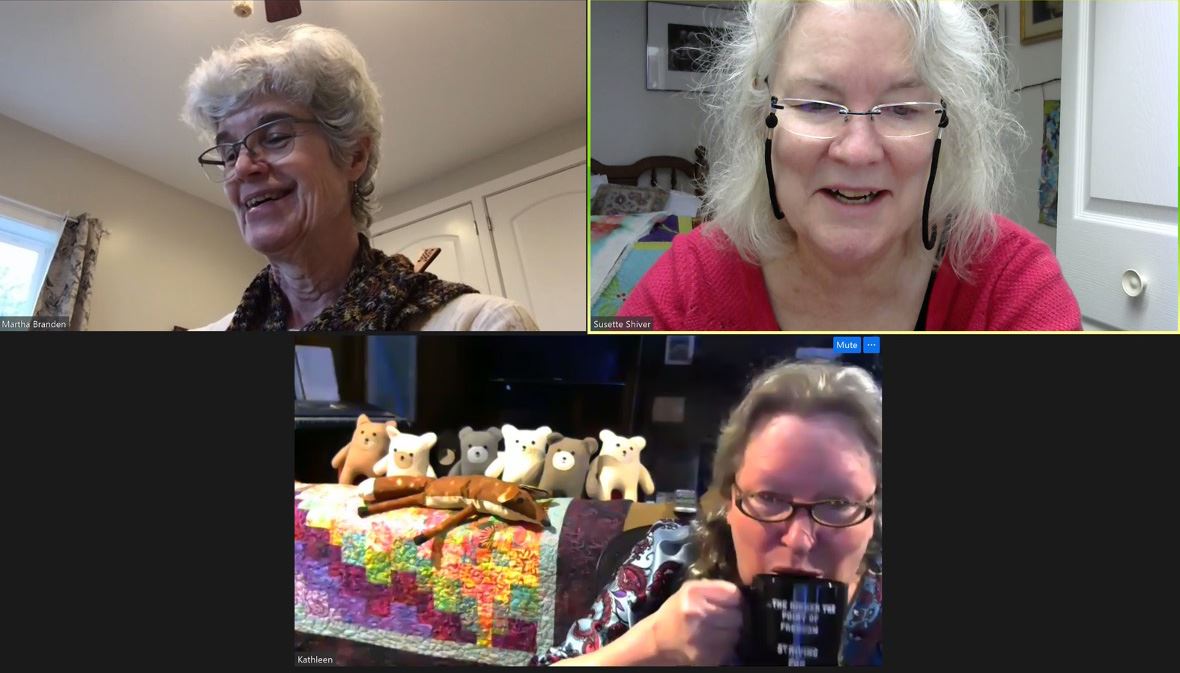



Martha is demonstrating something in the photo above, but for the life of me I cannot remember what!! The problem is unless I take notes and write the blog immediately, details fade. Since I'd rather knit and chat, I fail to write enough notes. At least this push-pull is trivial compared with the push-pull of home versus work obligations that I used to experience as a working mother!
 ....I am still trying to remember what Martha was talking about....ah! Perhaps it was when we were discussing Shibui yarns, Shibori knits, and Michael Smith's Shibori t-shirts.
....I am still trying to remember what Martha was talking about....ah! Perhaps it was when we were discussing Shibui yarns, Shibori knits, and Michael Smith's Shibori t-shirts.
First off, I had never heard of Shibui yarn. As I understand it, not having read in depth on the subject and not an expert myself, Shibui Knits, a small independent company, was founded in 2007 by Darcy Cameron in Portland Oregon. According to the Shibui Knits website,
"On a visit to Tokyo’s Ginza market in 2004, Darcy Cameron picked up a handwoven bag dyed with persimmons. She loved the bag’s pure simplicity, described by her Japanese friend as “very shibui,” or “elegant with a touch of bitterness.” This inspired an enduring aesthetic."
The Shibui Knits website store boasts already prepared and mixed yarns as well as the resources and instructions to blend your own yarn. Using different yarns, yarn weights, and blended fibers you have to power to design the texture and look of your yarn; i.e., you direct the production of your yarn to your specifications. Their mix of yarns is spun together to create different textures in the knitted fabrics. Check out their resources page for more explanation. This shop gets into the finer, more subtle details of knitting to allow you to explore textures and colors, to knit the project in the correct size you want, and using the best knitting techniques.
I have to admit, the first time I glanced at my notes, I misread Shibori for Shibui. Shibori yarn means dyeing hanks of yarn using tie, clamp, or other shape resist techniques. Shibori knitting or crocheting would be, similarly, using shape resist on knit or crochet fabrics. From Interweave: "Asian Influence and the Magic of Shibori Dyeing", one learns how to indigo dye a piece of cloth created by crochet.
I myself have hand dyed a knit hat and headband using Shibori clamp resist. The making of this hat reaches back to this past fall when I Iearned to spin yarn. In September 2020, I attended the Fiber Farmer's Day 2020, and joined the Spinning Study Group of Local Cloth (Sign up here)! This hat was made from hand spun Shetland fiber from Sourwood Fiber Farm, knitted, then Shibori clamp-resist dyed using pre-reduced indigo.
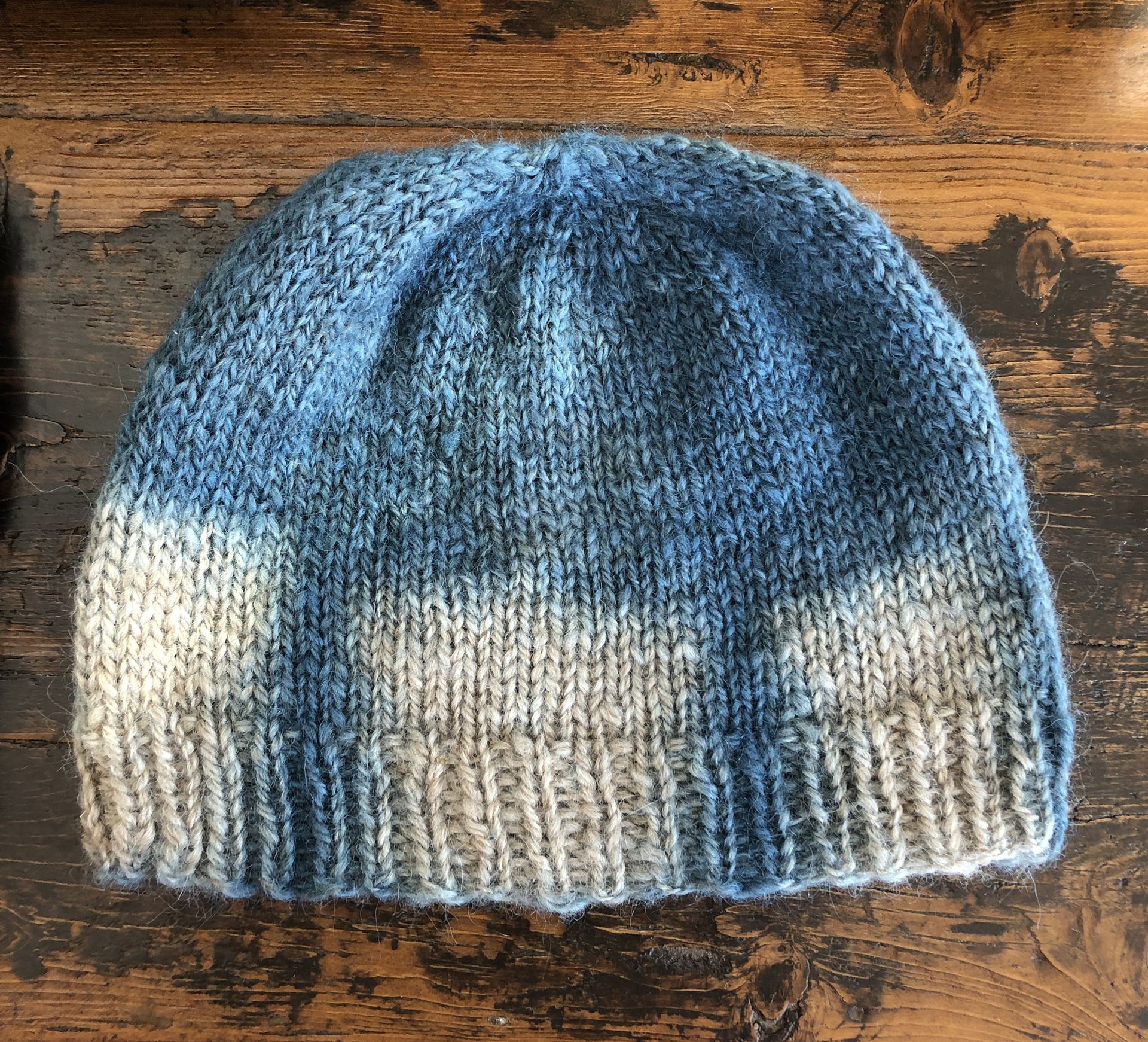
Another part of this Shibori discussion included Michael Smith. He is behind Manifest Color and you should check it out for stunning Shibori designs on silk for starters and an extensive line of men and women's t-shirts. His website is beautiful. If you are/were participating in Conversations on Cloth led by Yoshiko Wade and Ana Lisa Hedstrom, you might be able to visually parse the Shibori patterns to determine the type of Shibori resist used to create these complex designs.
Conversations with Cloth, Series I is hosted by Slow Fiber Studios and it has been an amazing learning experience for me. Yoshiko Wada covers the history of traditional Japanese Shibori forms showing many examples in photos and from her collection. She describes the techniques, both old and new, used to create them. There is rich inclusion of film clips as well. In the second portion of the 2 h presentation, Ana Lisa Hedstrom presents work from current artists producing high end Shibori art, including her own work. For those who missed it, these streaming 2 hour Zoom episodes were recorded and will be issued as DVD's with additional learning materials sometime in 2021.

Behind the quilt, in the photo below, Paula is holding up a recently finished quilt. In the next photo you will be able to see the contrasting front and back of her quilt. I apologize for the bad color representations in these quick screen shots! The true colors of the quilt are better represented in the small picture showing front and back beneath the larger photo.
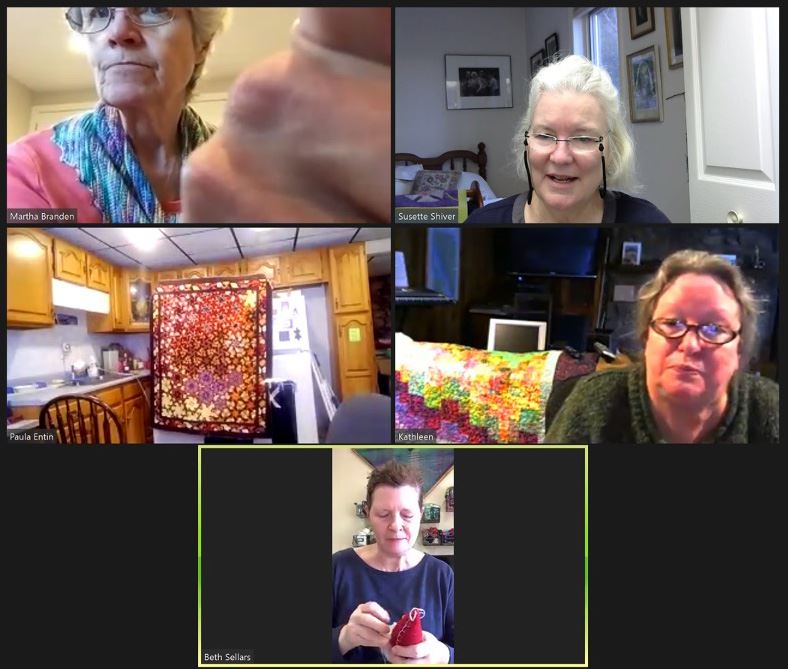
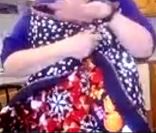

Martha Brandon has been making sweaters and such for grandchildren. She just finished a hoodie sweater from a book entitled Kids' Knitted Seaters and More- by Cabin Fever Designers (2006). However, if you want to get this book, it will have to be a second hand copy or you might find individual patterns from Cabin Fever Designers on Ravelry.
Kids' Knitted Sweaters and More - Over 30 projects by Cabin Fever Designers
I learned from Martha that a mattress stitch is the perfect stitch for attaching the hood since it looks the same on both sides. I'll have to ask her more about it and get a close up picture of the front and back of the hoodie she made. An internet search turns up, at top of the list, a YouTube video from Borocco Knit Bits. In this video they show how to use the mattress stitch for joining two stockinette knit pieces side-by-side. However, I imagined the hood attachment joins the top of the body to the bottom of the hood, so it might be quite different. Someone educate me!!
In our last session on Jan. 24, 2021, Myrna joined us for the first time from Burnsville. Myrna is a knitter amongst other things and she sent me several pictures illustrating her recently finished projects. The first photo shows The Lotus Crescent designed by Kieran Foley; the color work and the lace patterns surrounding the small color work patches is very eye catching. Kieran Foley's webpage is entitled Knit/ Lab, Inventive Knitting Patterns by Ken Foley. I think Kieran Foley is part of the current wave of interest in knitting, particularly multicolor and complicated patterns of fabric construction. I might have to buckle down and actually learn some new tricks for my knitting! Myrna's second piece is a scarf with frills from the Knitting Stitch Bible.
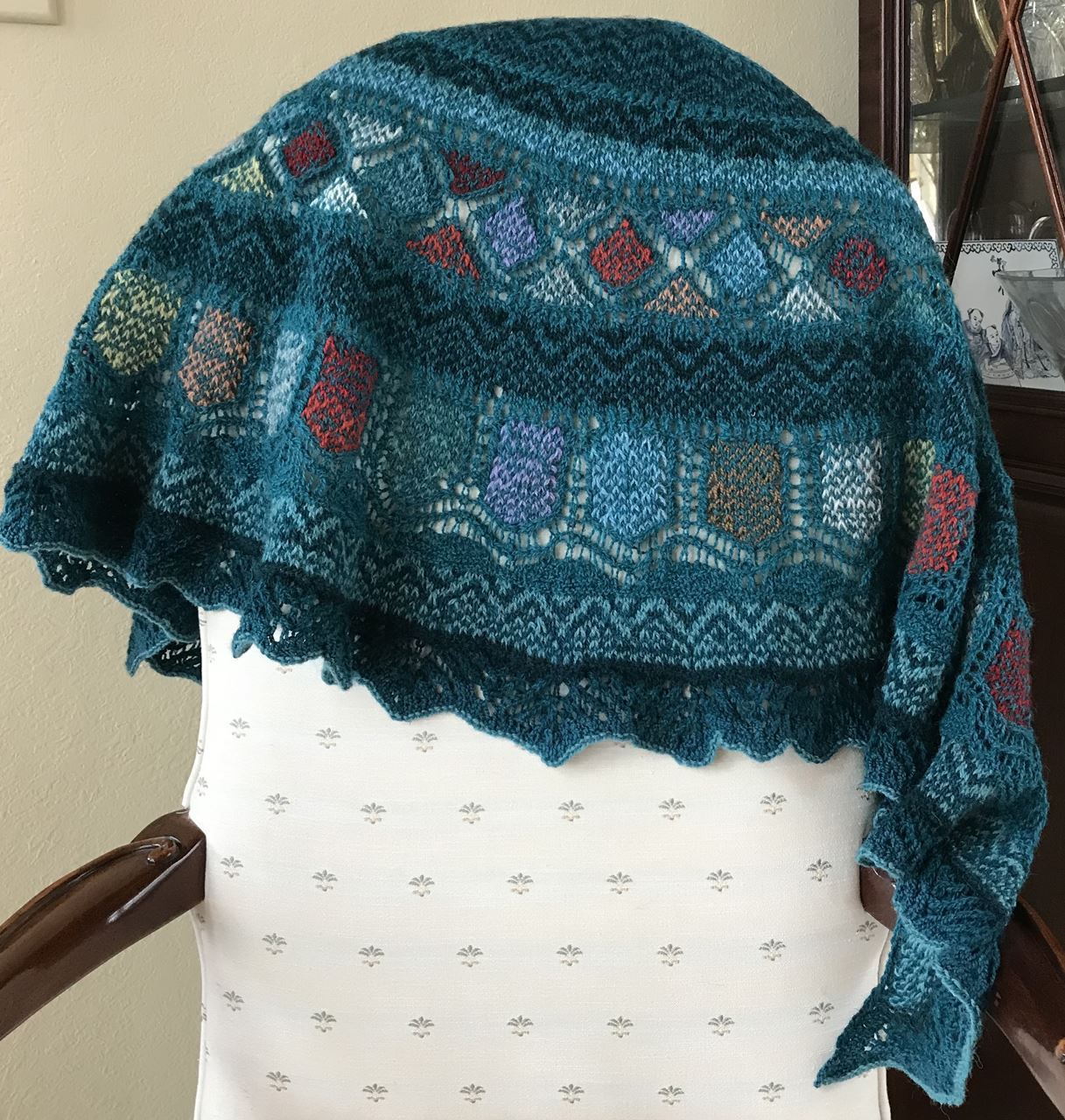
.jpg)
 We were marveling at something else that I ran across. The art of using two sets of circular needles to knit two socks at once (each in the round). A quickie exploration on the internet that we screen shared in our Zoom session, led us to Tin Can Knits, a website of patterns for knitted seamless garments. There we saw a detailed description of the magic loop method. Martha, a fount of knowledge concerning knitting, led the discussion on the best circular needles. I have a dozen or more circular needles, with different length cords and different sizes and style of points. What a mess in a box. I never have the one that I want. Martha suggested the interchangeable sets. Although much more expensive, in the end you have greater flexibility. Her first choice, Knit Piks, she would not recommend. However, Chiaoggo Twist, 4" or the 5" tip for larger projects are excellent. The cords are red lace and of interchangable lengths. I still will probably always knit socks and mittens on 5 double point needles (I have a complete set). However, one goal of mine is to make a seamless sweater of the top down variety, in the round. A higher goal is to do it using hand spun yarn. Even reaching higher, I desire to make a top down sweater using hand spun, hand dyed yarn, designed by me including some color stranded work. I will let you know in the next 10 years how it goes!
We were marveling at something else that I ran across. The art of using two sets of circular needles to knit two socks at once (each in the round). A quickie exploration on the internet that we screen shared in our Zoom session, led us to Tin Can Knits, a website of patterns for knitted seamless garments. There we saw a detailed description of the magic loop method. Martha, a fount of knowledge concerning knitting, led the discussion on the best circular needles. I have a dozen or more circular needles, with different length cords and different sizes and style of points. What a mess in a box. I never have the one that I want. Martha suggested the interchangeable sets. Although much more expensive, in the end you have greater flexibility. Her first choice, Knit Piks, she would not recommend. However, Chiaoggo Twist, 4" or the 5" tip for larger projects are excellent. The cords are red lace and of interchangable lengths. I still will probably always knit socks and mittens on 5 double point needles (I have a complete set). However, one goal of mine is to make a seamless sweater of the top down variety, in the round. A higher goal is to do it using hand spun yarn. Even reaching higher, I desire to make a top down sweater using hand spun, hand dyed yarn, designed by me including some color stranded work. I will let you know in the next 10 years how it goes!
See you soon! Join us 4-6 Fridays for our Virtual Handwork Circle! You can sign up on the Local Cloth Workshops page--look for "V-Handwork Circle".
